Imagine...
In the first half of nineties computing world was engaged in bit wars. PC's were getting first 32 bit and 64 bit graphics card. What do graphics bits actually mean? Nowadays many things, but back in post-VGA age it was simply about how many pixels can be drawn per clock. For example 64 bit graphics can draw two 32 bit pixels, at least under certain conditions. Sure, even back then graphics performance could not be reduced into dumb bit numbers, because even 2d graphics can be comprised of non trivial operations and smart techniques to get around simple width counts. But for uninformed consumer, along with clock speed, bits are what can get the performance expectations across. And so consoles, CPUs, OSes and graphics products were also fighting for higher bit counts. In 1993, when 64 bits was still cutting edge, Number Nine Visual Technology made a splash with wholly new Imagine 128 architecture. Massive bit count had to make it into the name for everyone to see. And it wasn't just a particular fat stage (typically video engines had more "bits"), but throughout the pipeline's graphics and internal processor right into the local memory bus, Imagine was 128 bits wide. Number Nine was in the spot light and not for the first time. They already pioneered 256-color and true color cards during the previous decade. Of course, such achievement came with a price tag and Imagine wasn't exactly interesting for casual home computers.
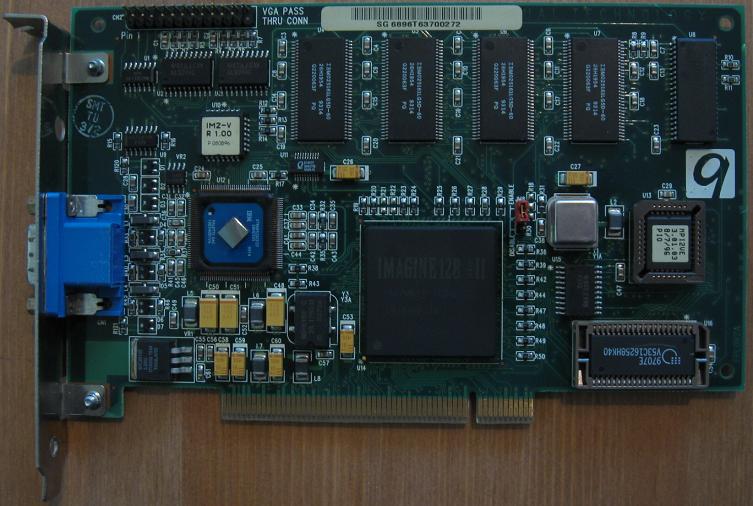 With flexible memory controller Imagine 128-II can use up to 8 MB VRAM and 32 MB DRAM for ultra high end.
This regular card has EDO chips on the right side serving the Cirrus 5424 at the back.
With flexible memory controller Imagine 128-II can use up to 8 MB VRAM and 32 MB DRAM for ultra high end.
This regular card has EDO chips on the right side serving the Cirrus 5424 at the back.Imagine series I, not to be confused with Arcobel Graphics Imagine I, was architected for the future and Number Nine delivered second generation in 1995 with many improvements. Series 2 integrates Intelligent Command Processor, a VLIW part allowing the CPU to send multiple drawing commands directly into the graphics memory bank for FIFO execution. CPU is also offloaded by hardware DIB conversion. The video engine got separated from drawing engine and grown even bigger- into 256 bits stage and 8 pixels per clock bilinear interpolations. More important to me is a 3d engine debuting with the Series II. In 3d space it can draw lines and Gouraud shaded triangles, perform 16/32 bit Z-buffering, volume clipping, and spatial blending. Imagine 128 II started with VRAM only, but later appeared cheaper DRAM option. 100 MHz memory controller could handle 800 megabytes per second single ported performance and with VRAM effectively even more. It has Direct3d compatible driver and it would be interesting to do some benches, but without texturing among my apps only d3d test and Turok runs. With claimed 610,000 Gouraud-shaded 50 pixel triangles per second in 16-bit color it should be very fast in what it can do. Under Windows NT OpenGL support should allow examinations, but I don't have the OS. Hardware texture mapping became a standard for accelerated games and while Number Nine remained on the top of 2d performers, serious entry into 3d graphics had to wait for next chip. Also, it should be noted both Imagines suffered in the transition from DOS to GUI systems just like other modern accelerators. N9 slapped a cheap Cirrus Logic chip with 512kB to take care of DOS, a common practice of the time. This soon proved inadequate for advanced DOS graphics applications including games. Later N9 wrote bios supporting Imagine II properly under DOS and sent it to customers upon request for free.
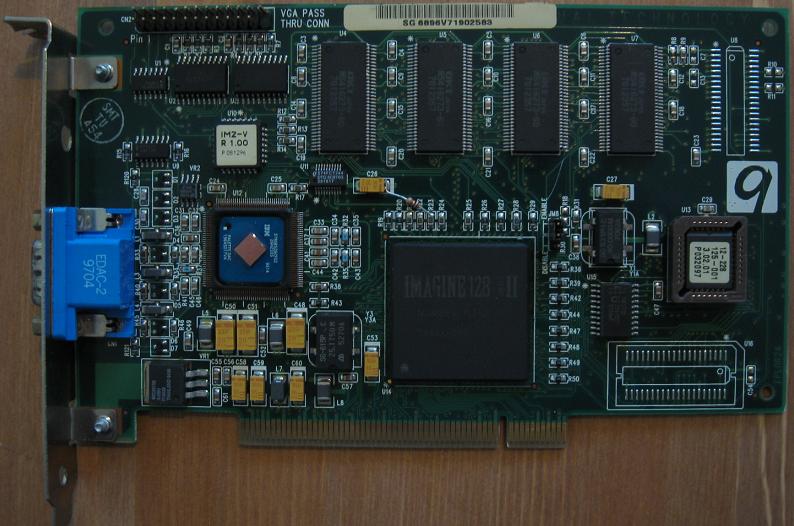 Mature version of Imagine II without Cirrus chip at the back.
Mature version of Imagine II without Cirrus chip at the back.After trying three different drivers I am confident enough to say Number Nine failed to deliver d3d driver with Z-buffering. Another reason for no real world benchmarks... With the little data I have, it looks faster than Millennium.
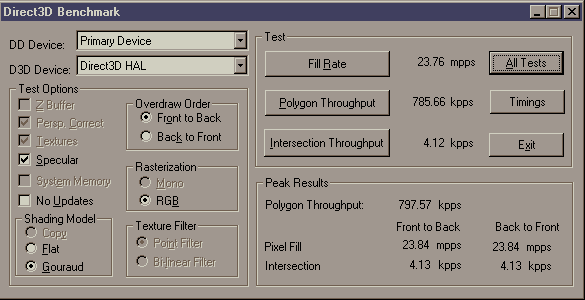
Last model based on Series 2 called Imagine 128-8 came out in spring 1997 and featured 8MB of H-VRAM for even higher bandwidth.
You say you want a revolution
During 1996 third series of 128 bit architecture was shaping up. New chip was named "Ticket to Ride", shortly T2R. Graphics card was named Revolution 3D, to show Number Nine's high ambition and dedication for three dimensional rendering. The architecture of T2R is still based on the Imagine technology, but 3d engine had to go through many changes. In front of rasterizer was added floating point setup engine with claimed 650 MFLOPS performance. Suspicously high number for the time. Of course texturing engine was added as well and right away backed by 8 kB big cache. It supports perspective corrected texture mapping with bilinear and trilinear filtering. Unfortunately, games revealed the engine as less mature than one would expect. Texture dithering interleave colors only between horizontal lines, perspective correction lacks a little more precision to be really accurate and stable. Bilinear filter dissapointed most, interpolation is far from per pixel operation, Revolution 3D settles with filling tiles around 8x8 pixel big with one or two colors. Specular lighting, interpolated fogging and all important blending modes should be implemented as well. Even the 3d stages are 128 bits wide, which could mean full speed 32 bit rendering. Effective memory bandwidth is further improved by WRAM support. Basic 3d specifications look nice, while 2d and video are still top notch and at a more friendly price. Is this the board that mastered everything?
Revolution 1
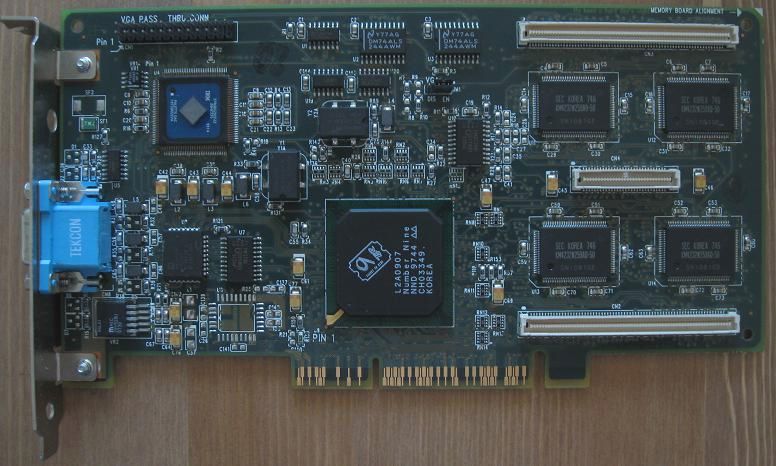 N9 wanted to attract other board partners, but I only saw their own products.
N9 wanted to attract other board partners, but I only saw their own products.That is again one huge chip, the whole board gives appropriate serious business impression. First cards were for PCI, then in August AGP version started shipping. From what I saw in the auctions, PCI boards did not really catch on, despite no support for advanced AGP features. WRAM ended up being the only memory type used, T2R supports 48 MB of them. However, I am not aware of cards and memory expansions with more than 8 MB, totalling at 16 MB actual maximum. The expansion might come in handy if you want to max out possible high resolution 3D modes. Powerstrip reports 58 MHz clock speed. From there it can be pushed to 70 MHz, then artifacts begin to appear. The chip nonetheless remains very cool, but also performance does not scale very much. Ramdac is not yet integrated, but this was still common for professional boards with very high resolution support.
I've Got A Feeling
When it comes to games no revolution is happening, Ticket to Ride has some serious issues for 1997. There are no total losses as such, but low resolution tests are missing because anything below 640x400 is not supported. Light mapping in Shogo is broken and to finish long demo it had to be disabled, otherwise reset button was needed for the rescue. I had hard locks in few other games but not repetetive. My biggest complaint is how the Revolution cannot deliver image quality it's feature set should. There are many examples of ugly or just broken blending in the gallery. Lightmapping in newer games is off limits. There is no OpenGL support for Windows 9x so I resorted to Techland d3d wrapper. In first Quake world is not textured, Sin fails altogether, but newer Quake games are at least recognizable. Then there are issues to blame drivers for. Revolution 3D sometimes shoots itself by preferring 15 bit textures instead of 16 bit. Despite not gaining any speed this high end board will often draw awful colors unless the game lets you set texture format. On top of that 15 bit textures are often rendered incorrectly with green and black colors, and opaque, which is for example really a downer for windows in Dark Forces 2. 8880 textures can be drawn, but blending operations are failing. At least 32 bit color depth is safe bet, Revolution 3D has the horsepower for full speed true color and does not lose much steam even when increasing resolution above 640x480.

Hawkeye can have all the settings for desktop management, but 3d settings are almost non existent. The alternate blending checkbox helped me to fix some texture transparencies in Turok, Falcon 4.0 and Final Reality. Performance can dive significantly though. Revolution 3D had fast enough geometry and fill rates, but blending operations, when working, are often too costly. Furthermore, sometimes they appear very inaccurate, when more transparent levels intersect final colors are often too bright or too dark.
The Fast Specular Function checkbox made no difference to me.
 Smoke, the big enemy of Ticket to Ride. Visit whole gallery.
Smoke, the big enemy of Ticket to Ride. Visit whole gallery.
Don't Let Me Down
Picking a contender was easy, the card with nature closest to Revolution 3D is Millenium II by Matrox.
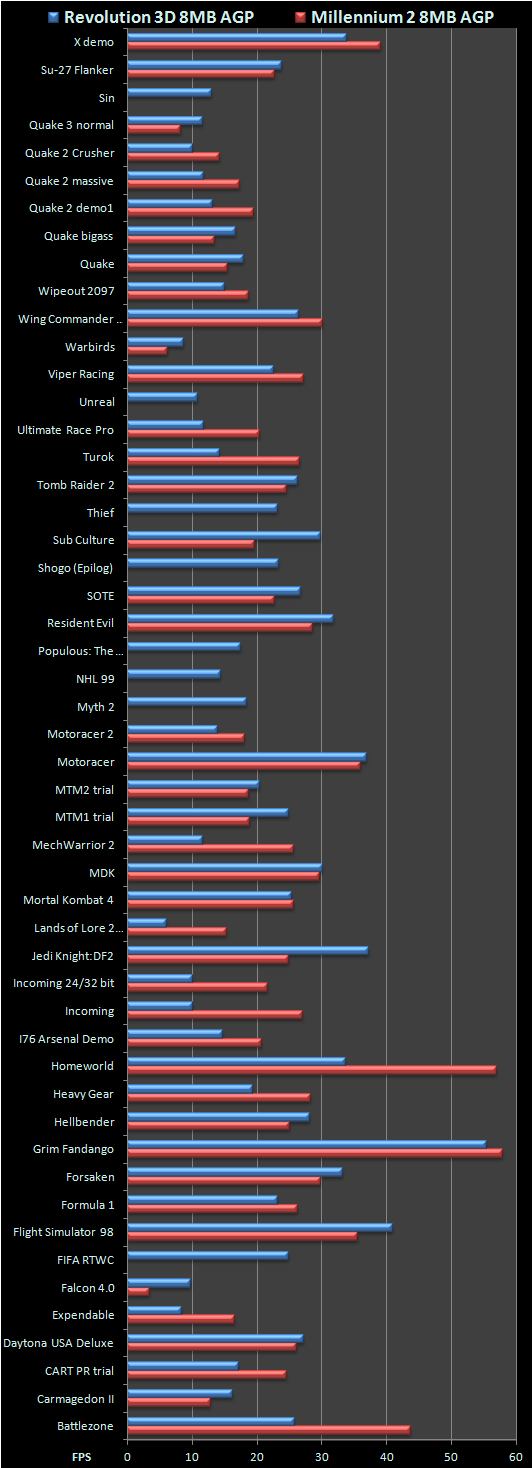
And it is a close race for framerates, in both average and minimal these competitors are equal. Even then the Revolution 3D, with all it's image quality troubles, draws almost every game better than backward Mystique 3d architecture. So it seems Number Nine eclipsed Matrox in every regard, but at a price point not many were willing to pay. Still not good enough offer to attract gamers, since Ticket to Ride is lagging behind better 3d chips of 1997. Realistically Ticket to Ride needs two clocks per 3d pixel even in simple scenes.
Revolution 9
Outside of three dimensional rendering Revolution 3D was certainly high-end accelerator, but its performance was demanded only by niche market. Under extreme competitive pressure Number Nine had to reduce prices below expectations and financial situation was worsening. If it wasn't for some money influx from the likes of SGI, who knows if we would see their last chip come to light.
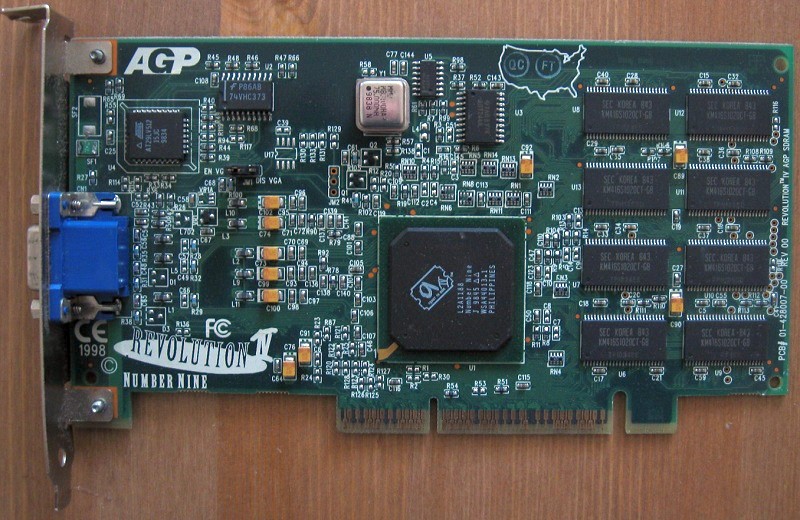 Revolution IV with Ticket to Ride 4 chip
Revolution IV with Ticket to Ride 4 chipFourth generation could still utilize WRAM, but as SGRAM was becoming a lot more viable T2R4 introduced programmable latency memory controller to squeeze up to 25% more bandwidth out of them. Boards were equipped with 32 megs of synchronous memory with bandwidth over 2 GB/s. 3d part was updated to keep up with times, 10-level of detail mip-mapping with trilinear filtering and full AGP 2X support was added. It promised high-end 3D gaming capabilities supporting higher resolutions and frame rates than most existing 3D gaming cards. Under the name WideBus technology was introduced Intelligent Resource Processor directing graphics data through several 128-bit wide paths into two separate, yet integrated and tightly coupled 128-bit graphics engines- one for 2D, one combining 3D and video. 250 MHz DAC was integrated into the chip. But in 3d Number Nine was lacking behind just like with previous products and 2d advantage was less and less appealing. And since the company was not that successful even as a card manufacturer for S3, change of business became a must. The strategy of balancing high end with consumer market needs turned into schizophreny for some other companies as well. In 1999 Number Nine made a clear cut and started a new project with PixelFusion for pure high end accelerator. However, it was not finished and by the end of the year bankruptcy was declared. S3 acquired all assets and intellectual property.